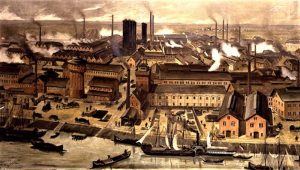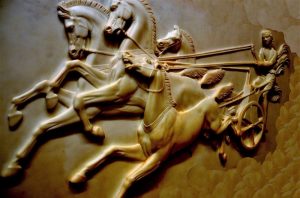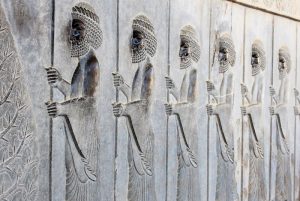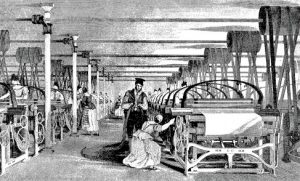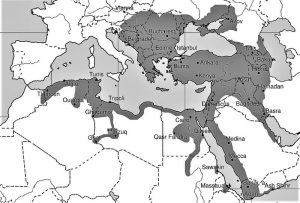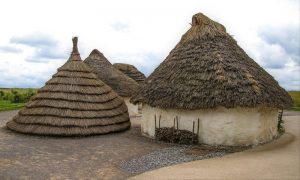Persian Empire
The ancient Persian Empire was one of the kingdoms most recognized for its majestic and marvelous structures located in the desert, for its great wealth and for its perfect military skill; a place governed by kings who exercised great power and ambition, and who managed to conquer from North Africa to Asia. Immense and extraordinary advances were needed in the area of engineering, not only in the construction of its buildings, but also in the creation of roads, bridges and canals.
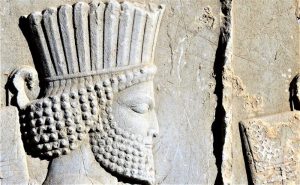
- Foundation: 550 B.C.
- When it ended: 330 B.C.
- Capital: Susa, Persepolis
- Religion: Zoroastrianism
- Government: Monarchy
What is the Persian Empire?
The Persian Empire were groups of different dynasties that inhabited a vast territory, where cultures were respected and who were responsible for governing Persia mainly during the Empire Achaemenid with Cyrus II the Great.
- Summary
- Origin of Persian Empire
- Stages
- Fall of the Persian Empire
- Characteristics
- Founder
- Location of the Persian Empire
- Extension
- Political and social organization of the Persian Empire
- Kings
- Economy
- Cultural events
- Customs and traditions
- Religion
- Nutrition
- Contributions
- Capitals of the Persian Empire
- Importance of the Persian Empire
Summary
The Persian people is of Indo-European origin and was people subdued by the Medes, an Asian kingdom settled in the rivers of Mesopotamia and who could expand their territories thanks to King Cyrus II the Great, belonging to the Achaemenid dynasty, who also freed them from the Medes.
The Persians expanded their territories, thanks to King Cyrus II who helped them achieve independence from the Medes, who made the Persians their subordinates. The Persian forces went to Lydia and Ionia, conquering them; they attacked Babylon, and controlled Mesopotamia, Syria and Palestine, liberating, in the same way, the Israelites in captivity. They also conquered Egypt and had the support of the Greeks.
Philip II, King of Macedonia, planned to seize the Persian Empire, but died. However, his son, Alexander, took the throne and completed his father’s mission. He achieved Greek dominion over Mesopotamia, Palestine, and Egypt, and then dominated Iran and Central Asia, marking the end of the Empire.
Origin of Persian Empire
The origins of Persian Empire date back to 2000 B.C. when the region was occupied by a series of pastoral peoples and farmers, known at that time as Medes and Persians. These Medes invaded the Iranian plateau and the Persians settled south-east of the Iranian plateau closest to the Persian Gulf.
Stages
The stages of the Persian Empire were:
- Medical wars: wars between Persians and Greeks to dominate the cities of Asia Minor. The end of these wars made the Persians spread to Europe.
- From Xerxes I to Artaxerxes II: it was a period of expansion and loss of some territories. With the death of Artaxerxes, I the capital was moved from Persepolis to Babylon. Aramaic began to be spoken and the solar calendar was introduced.
- End of the Persian Empire: Bagoas caused Darius III to occupy the throne but he had no experience as a ruler. Alexander the Great entered Egypt and was seen as a liberator of the Persians.
Fall of the Persian Empire
The beginning of the end of the Persians came with the defeat in the Medical Wars, when they failed to face the Greek army, and a series of social and cultural factors that brought down the essence of the empire’s unification. After the governments of the last Persian emperors, Artaxerxes I and Darius II, central and peripheral politics gradually degraded. There were many intrigues and conspiracies between families in search of power and the provinces, they gradually lost the bond that united them.
In 330 B.C., Alexander the Great found disarticulated and chaotic regions that he could easily conquer. His passage to the East is the end point of an empire in which values such as tolerance and respect for other cultures played a decisive role in good governance.
Characteristics
The main characteristics of the Persian Empire were:
- It was a tolerant civilization with the other ethnic groups.
- People had different cultures and religions.
- They ruled by satrapies.
- They made coins in order to trade with other peoples.
- The administrative structures were maintained.
- A unified system of weights and measures was created.
- They focused on combating crime.
Founder
Its founder was Cyrus the Great, who after defeating the Medes, Lydians and Babylonians, extended his dominions all over the place. However, its real organizer was Darius, who managed to expand the borders with the definitive incorporation of Egypt.
Location of the Persian Empire
The Persians unified several peoples of the Fertile Crescent, and their borders stretched from the Mediterranean Sea to the Indian Ocean. They inhabited the Iranian Plateau, east of Mesopotamia, a semi-arid region, with mineral-rich mountains, deserts and few fertile valleys, a dry climate, with large temperature fluctuations.
Extension
The Persian Empire was the largest the ancient world had ever seen, extending from Anatolia and Egypt through western Asia to northern India and central Asia. The Persian Empire expanded under the leadership of Cyrus the Great, who used a strategy of religious and cultural tolerance to maintain order.
The society was formed by the king who was considered a god and lived in the capital, the royal family was quite extensive, and the king had a harem, so the monarchs had many children, there was the group of nobles who were the wealthiest families and were members of the court. Priests were a pillar within society and there were many temples. The soldiers were in charge of protecting the borders, the plebs were a class made up of peasants and artisans and the slaves who came from the wars, were property of the state and were small groups.
Kings
The kings of the Persian Empire were: Cyrus II, Cambyses II, Esmeridis, Gaumata, Darius I, Xerxes I, Artaxerxes I, Xerxes II, Sogdian, Darius II, Artaxerxes III, Artaxerxes IV, Darius III, Artaxerxes V. The kings of the Persian Empire were: Cyrus II, Cambyses II, Esmeridis, Gaumata, Darius I, Xerxes I, Artaxerxes I, Xerxes II, Sogdian, Darius II, Artaxerxes III, Artaxerxerxes IV, Darius III, Artaxerxerxes V.
Economy
It was based on agriculture, irrigating with water from the mountains, grazing and mineral extraction. They practiced a wide trade thanks to the creation of the coins, this coin was called Daric, and they were minted in gold which stimulated the internal and international trade.
Trade caravan routes passed through Iran from India and China to the Mediterranean Sea. Trade managed to give an important boost to the industry of luxury textiles, jewelry, mosaics and rugs and carpets.
Cultural events
- Painting: fresco painting and manuscripts were common and during the Islamic period, painting was the most important art. They used to paint on a red background, blue and gold Their paintings depict individual figures, but groups of pilgrims and Dervishes were also painted. They made monochrome ink drawings with slight touches of red and gold replaced the brilliant polychromies of the first manuscripts.
- Architecture: they had beautiful palaces built on fifteen-meter high platforms with staircases and wooden ceilings. The main palace was that of Darius of Persepolis, and the palaces were decorated with winged bulls, with tall cylindrical columns decorated with leaf shapes.
- Sculpture: winged bulls were sculpted to adorn temples. They used stone and clay and sculpted low reliefs to represent warriors with lances, bows and arrows, winged anthropomorphic bulls.
Customs and traditions
They accepted foreign customs and for this reason they wore the Medes costume because they thought it was more distinguished and they also used Egyptian bibs for wars. They married several wives and had a higher number of concubines. They taught their children only to ride horses, shoot bows and tell the truth. They considered that lying was the greatest dishonor and contracting debts was shameful. People suffering from leprosy were considered impure for having committed a crime against the sun and if they were foreigners they were taken out of the country.
They had no temples or images of gods because for them they had no human nature. They made sacrifices and sang hymns to the gods. They celebrated their own birthdays, greeted each other with kisses on the mouth if they were of the same social class or on the cheek. Neither did they make funerals or burials because they considered that they soiled the earth for this reason they let the animals and vultures eat the bodies of the dead.
Religion
The religion of the Persian Empire came from sermons of the prophet Zoroaster, the Zoroastrianism. The sacred book of the Persian religion was known by the name of Avesta and focused on the existence of two spirits: one called Ahura-Mazda, which was the god that represented good, and Angra-Mainyu which represented evil.
They had concepts related to the final judgment in which the spirit of the dead was judged depending on what he had done in life and that would define his future in his new life after death.
Nutrition
The Persians fed mainly on bread, sesame oil, wine and fish. Their diet improved as time went by thanks to the defeated peoples, and they dedicated themselves to the cultivation of wheat, grapes, walnuts, rice, and so on. Meat was eaten by both the poor and the rich.
Contributions
Perhaps the main contribution of the Persian Empire was the way in which they obtained their income and wealth. They made great inventions, banking systems and credits that were later put into practice by the Greeks and Romans. They left a system of weights and measures, irrigation systems and proper use of water, construction techniques and surveying, we inherited their algebra, geometry, chemistry and physics.
Capitals of the Persian Empire
The capitals of the Persian Empire that were used to rule were:
- Susa: the oldest city in the world. It was founded by the Elamite peoples, who turned it into their capital and filled it with palaces and temples. The Assyrian kings destroyed it and when the Persians arrived, they turned it into their main capital, which would be the administrative center of the empire. It was grandiose, luxurious, mythical and the place where some of the most important events in the history of Persia took place.
- Ecbatana: one of the largest cities in the empire, with a concentric organization organized in rings separated by walls and in the center was the royal palace.
- Pasargada: founded by King Cyrus II and was the ceremonial capital of his empire. This city became famous for having the tomb of Cyrus the Great and for its gardens The Pairidaeza.
- Persepolis: the most important Persian capital made of palaces. It was a spring residence, where important festivities were celebrated. The main palace was called the Apadana and was an audience hall for the Persian kings. The Treasure was built to keep the riches of the empire.
Importance of the Persian Empire
Thanks to the Persians, the most important empires in the world were created, such as the Roman Empire, the Greek Empire, etc. They inherited great discoveries such as the existence of underground water, invented wells that are even the same one used to extract oil, invented canals and left ideas of freedom and respect for other cultures.
How to cite this article?
Briceño V., Gabriela. (2019). Persian Empire. Recovered on 23 February, 2024, de Euston96: https://www.euston96.com/en/persian-empire/



